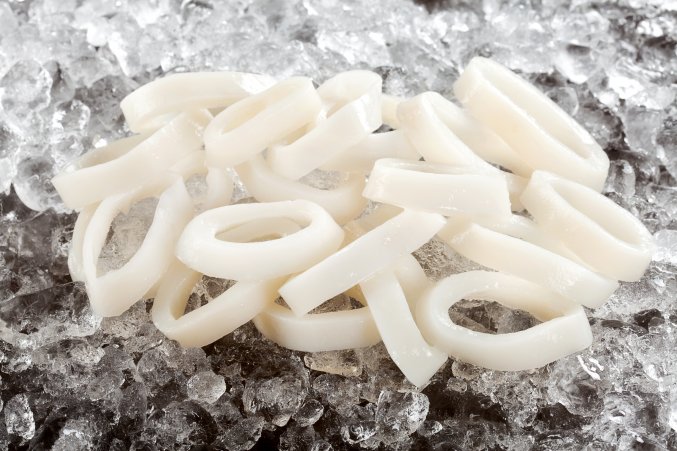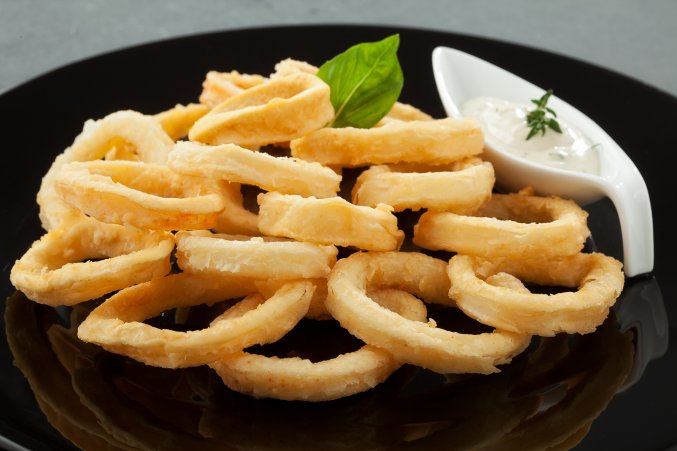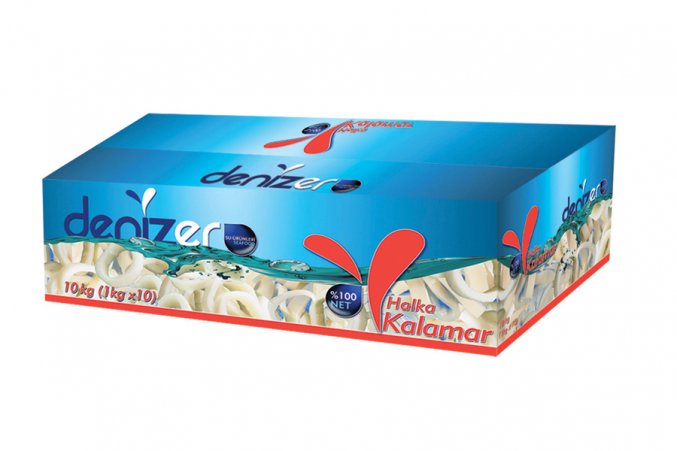Pacific Squid Rings
This Todarodes squid has a big market share and especially caught in Japan, Korea and China in high amounts. The biggest importer is America. They can live up to 1 year, grow up fast and migrate for spawning. A great majority of them spawn in Eastern China waters, the second group spawn in autumn in Kyushu Island and the third and the group with the least amount spawn in spring in Japan. They are catched by hook machines, deep trawls, nets and purse seine.
It is a very delicious squid and sold as especially ring and tube.
Product Description
|
Product name |
Denizer Deep Frozen Pacific Squid Rings 10 kg |
|
Latin name |
Todarodes pacificus |
External barcode
|
8680539202001
8680539202018 |
|
Internal barcode |
- |
|
Size |
Meat width: 1-1,2 cm / Diameter: 3-7 cm / Size before glazing √ / Size after glazing |
Product description
|
After catching, squid is cleared of tentacules, innards and skin, treated acc to EU standards, freezed immediately, glazed at the rate of protecting glaze. After freezing, the product is packed in 1 kg polybag. |
|
Freezing type |
IQF (Individual Quick Freezer) |
|
Packing type |
10x1 kg polybag |
|
Ingredients |
Squid rings (100%), water (3-5%) |
|
Production type |
Farmed / Catch √ (FAO : 61 ) / Value added |
|
Origin |
China |
|
Units per package |
- |
|
Glazing rate |
3-5% |
|
Product type |
Cleaned Squid rings |
|
Broken pieces |
Max 5 pcs / 10 kg |
|
Appearence |
White meat, specific appearence |
|
Smell |
Specific, normal smell |
|
Taste |
Specific, not bitter or sour, normal taste |
|
Texture |
Strict, not dry |
|
Average weight |
- |
|
Shelf life |
After production date, first 24 months |
|
Additives |
EU standard treatments (Max 5 ‰) |
|
Outer package |
Min 4 colored printing microwave corrugated cardboard box (PAP) (30x43,5x28 cm) |
|
Inner package |
PE polybag with rider |
Packing criteria
|
The total migration value of components of plastic substances and materials to foodstuff, per square decimeter surface area of substance or material can not be more than 10 mgs. This value is defined as the limit of total migration of plastic substance and materials (mg/dm2). |
Storage conditions
|
Should transport and storage at min -18°C. Transportation should be without contamination and complete with no break of cold chain. |
Nutrition facts
|
Energy (kcal/100 g) |
92 |
|
Fat (g/100 g) |
1 |
|
Protein (g/100 g) |
16 |
|
Cholesterol (mg/100g) |
233 |
|
Na (mg/100g) |
44 |
|
Carbonhydrate (mg/100g) |
3 |
|
Vit A (%/100 g) |
1 |
|
Vit C (%/100 g) |
8 |
|
Ca (%/100 g) |
3 |
|
Fe (%/100 g) |
4 |
|
Omega 3 (g/100 g) |
0,486 |
Chemical Parameters
|
Hg (mg/kg) |
0,5 |
|
Cd (mg/kg) |
1 |
|
Pb (mg/kg wet weight) |
1 |
|
Total max dioxins (pg/g wet weight) |
3,5
|
|
Total max dioxins and dioxin like PCBs (pg/g wet weight) |
6,5
|
|
Total PCB28, PCB52, PCB101, PCB138, PCB153 and PCB180 (ng/g wet weight) |
75
|
Microbiological Parameters
|
Histamin (mg/kg) |
200-400 |
|
Salmonella spp(g-ml) |
0/25 |
|
Listeria monocytogenes (g-ml) |
0/25 |
Legal Criteria
|
GKGM Regulation on water intended for human consumption |
|
GKGM Regulation on microbiological criteria |
|
GKGM Regulation on contaminants |
|
GKGM Regulation on labelling |
|
GKGM Regulation on packaging waste control |
|
GKGM Statement of plastic materials in contact with foodstuffs |
|
Turkish Food Codex Regulation |
Determination of Net Weight
|
Remove package from low temperature storage, open immediately and place contents under gentle spray of cold water. |
|
Agitate carefully so product is not broken. |
|
Spray until all ice glaze that can be seen or felt is removed. |
|
Transfer product to circular No. 8 sieve, 20 cm (8”) diameter for packages #0.9 kg (2 lb) and 30 cm (12”) for packages >0.9 kg (2 lb). |
|
Without shifting product, incline sieve at angle of 17-20E to facilitate drainage and drain exactly 2 min. (stopwatch) |
|
Immediately transfer product to tared pan (B) and weigh (A). Weight of product=A-B |
|
*Acc to AOAC official method 963.18 net contents of frozen seafoods glazed foods |
Spawning
|
Jan |
Feb |
Mar |
Apr |
May |
Jun |
Jul |
Aug |
Sep |
Oct |
Nov |
Dec |
|
X |
X |
X |
|
|
|
|
|
|
|
|
|






